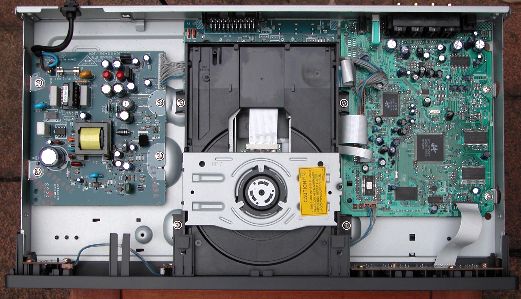
The NAD brand has long been synonymous with good performance and value for money - it is the brand that many knowledgeable consumers have gravitated to when they have hi-fi aspirations but lo-fi budgets. Started by a group of audio retailers and distributors who were annoyed by the lack of affordable good quality electronic components, NAD had a simple and very successful formula: brilliantly simple and elegant designs, over-specced components and a low price due to the use of outsourced manufacturing in the Far East. NAD sells a full range of audio and home theatre components as well as all-in-one systems, and their philosophy of plain looks, good performance and budget-conscious pricing apply across their entire range.
The T 513 is NAD's newest and lowest priced DVD player, replacing the T 512. The new model adds both PAL and NTSC Progressive Scan and component video output (whilst retaining support for SCART RGB and composite. In addition, the player now supports WMA (audio only) files as well as JPEG/Kodak Picture CD images in addition to MP3.
The full list of formats supported are:
There is no support for advanced audio formats such as HDCD, Super Audio CD or DVD-Audio, nor emerging video formats such as Microsoft's WMV-HD or DivX/MPEG4.
The price of the T 513 is $399. Given that equivalent progressive scan players from NAD's competitors are priced at less than $200, NAD is probably hoping that prospective buyers will be attracted to the NAD brand and willing to pay a premium. But do you actually get better quality for that premium? Let's find out ...
The review unit I received seemed to be a production unit, and it came in a box weighing 4kg. Inside the box were:
The review unit is in NAD's traditional dark grey colour, and anyone who is familiar with NAD's product designs will be very familiar with the rounded buttons and sparse, minimalist look.
The player is fairly small and light, with a construction quality not too far removed from "supermarket special" DVD players except that it is based on a metal chassis rather than plastic. In operation, the review unit was noted to have a slightly faulty transport: whenever the tray was opened, it had a tendency to automatically retract the tray within a few seconds, and before a disc could be inserted/removed/replaced. I suspect this was because the opening action was a bit too forceful, and thus when the tray hit the fully opened position, the sudden and forceful stop triggered the automatic closing mechanism. I hope this fault is not a common one, or at least easily remedied.
Opening up the unit revealed a logical layout, with the power supply (left), the transport unit (middle), and on the right a single board housing the majority of the electronics. There is a small circuit board at the back (behind the transport) that outputs SCART (composite and RGB).

Inspecting the chipset reveals a very basic design similar to that found in many cheap "Made in China" DVD players - nearly all the transport and decoding logic is provided by a pair of MediaTek chips: the MT1379DEC "DVD Player on a single chip" and the MT1336E transport controller. The video driver (combination DAC and amplifier) is a Mitsumi MM1623 which supports 6 channels with 10-bit/54MHz resolution. However, it is clocked by a KITEL 338 27.000MHz oscillator, so I suspect the MM1623 is only operating at 27MHz instead of 54MHz.
In homage to NAD's reputation for good quality audio, the audio stage is based on superior components to that typically found in cheap and nasty DVD players. The audio DAC is a 4391K 2 channel delta sigma design, feeding a 2604AU dual channel op amp.
Other chips include the usual memory chips (two Hynix HY57V161610DTC 16Kbits DRAMs and an AMD 29LV800 flash memory).

The front panel consists of:
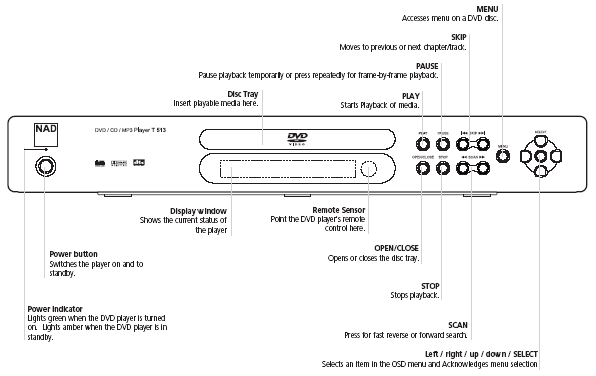
This is a good design, and does not look too cluttered whilst allowing the majority of disc navigation to be performed on the front panel without a remote control - very handy if you can't find the remote! I would have liked the buttons to be a little more differentiated, but I understand NAD's desire for design consistency across their entire range.
The front panel display has bright cyan LEDs with some enunciators in orange:
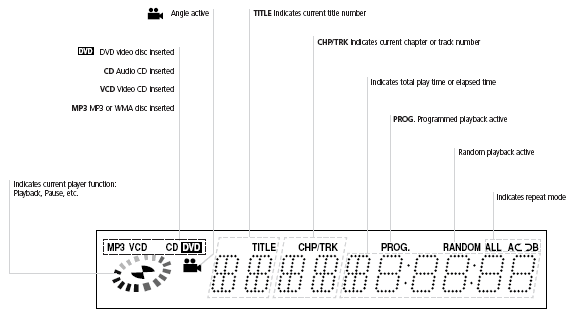
Nice and minimalist, although the animated "spinning disc" is a bit cheesy.
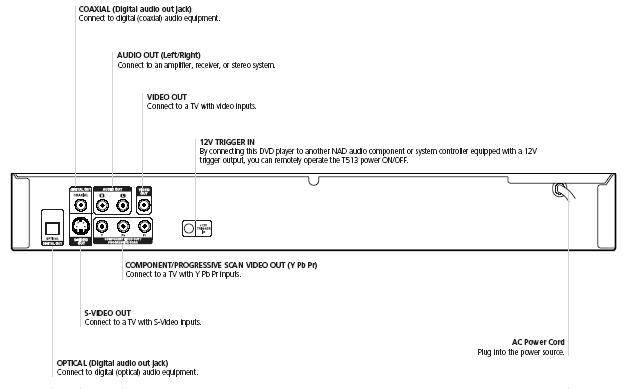
NOTE: there is also a SCART connector (supporting composite and RGB) in the centre which is not shown in the above diagram. The inclusion of a 12V trigger is unusual at this price point.
The remote control is designated DVD 5:
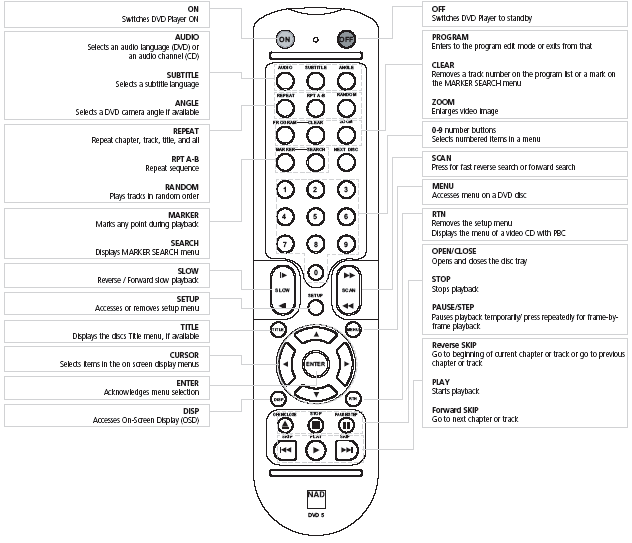
The remote control is another area where NAD's careful attention to usability puts them a level above their mass market competitors. This is not the prettiest looking remote, and it is certainly not the smallest, but it's fairly usable. A backlight would help, plus buttons that are more differentiated, but it has more or less an appropriate set of buttons, and all of them behave very much like you would expect them to. The "Next Disc" button is of course not functional on this player, but the others are. Most of the buttons are shift toggles - pressing them repeatedly will shift across multiple available states, eg. pressing the ANGLE button cycles through available camera angles, AUDIO cycles through available audio tracks.
The manual is multilingual and divided into two A4 sized volumes, each containing 4 versions of the manual in different languages. Volume 1 has versions for English, French, German, and Dutch. Volume 2 has versions for Italian, Spanish, Portuguese and Swedish. The English version is 29 pages. It is crisp and succinct, and contains the minimal information to get you going, but frankly, after the initial setup you probably won't need it.
The set-up menu is accessed by pressing the Setup button which brings up a list of setup parameters. You navigate across parameters by pressing the up/down arrow keys. To change specific parameter, you select the right arrow key, then use the up/down arrow keys to select the desired setting, followed by pressing ENTER to confirm your selection. You can exit the set-up menu by pressing SETUP, RTN or PLAY keys.
The set-up menu contains the following parameters:
There are two additional set-up parameters not available from the set-up menu. Pressing and holding the PAUSE button on the front panel for over 5 seconds with no disc in the tray toggles the player video output settings (AUTO, PAL, NTSC). Pressing and holding the DISP button for 3 seconds whilst a disc is playing toggles the progressive scan mode:
I would have liked to see a black level setting (IRE 0/7.5).
I calibrated the player by adjusting the display settings of my Sony VPL-VW11HT LCD projector (and leaving the Picture Mode of the DVD player on "Standard") using the Digital Video Essentials test disc (PAL/NTSC) plus the older Video Essentials (NTSC). The player's video output must be close to reference levels, for the optimal adjusted settings were the same as the default settings.
I only tested the player in progressive scan mode (for both PAL and NTSC titles). I did briefly put the player in interlaced mode to verify that it outputs interlaced video correctly.
The review unit is multi-region enabled and I had no difficulty playing a number of Region 1, 2 and 4 discs (including R1 RCE discs). Even discs that do not play properly on my old player - the Pioneer DV-626D - (including When Harry Met Sally and the layer change of several discs including Fried Green Tomatoes) play perfectly fine on the DVD-2900. I am not sure whether retail units will be multi-region enabled out of the box.
Given that this is effectively an "entry level" player for NAD that is not too dissimilar to bargain priced players, the quality of the video output is only average. However, unless you are very very picky (and have a very high resolution display) you will probably not notice most of the problems and the player should perform adequately on most TVs (especially if progressive scan is not used).
The player performed okay on most of the tests in Digital Video Essentials. It passed through all the picture resolution patterns (Title 13) with no problems. It also performed adequately on the Snell and Wilcox Anamorphic Zone Plate motion patterns (Title 16). It performed the A/V timing test in Title 11 with no issues, indicating that the player should not have any problems with lip sync and audio synchronization.
Resolution of still images is perfect, but the player pixelates on very fast moving low level detail (as evidenced by the computer generated animation in Digital Video Essential's video montage - Title 17 Chapter 2). For example, there's quite a lot of shimmering and moire patterns around Daryl's tie (worn by Freddy) at 20:52-21:37 in the R4 edition of Double Take.
The player is also fairly susceptible to ringing, and will accentuate Gibb's effect and edge enhancement artefacts.
Slow pans were reasonably smooth and marred only by the occasional micro-stutter.
At first I did not notice any signs of chroma issues, such as the chroma upsampling error or interlaced chroma upsampling artefacts. However, upon very close inspection during the (animated) main menu of the Region 1 release of Saturday Night Fever, I did notice that there are vestiges of jagginess in the pulsating red boxes - so, the MediaTek MT1379 is probably applying some sort of filter on the chroma channels. Slight jagginess can also be noticed due to interlaced chroma upsampling, for example the animated menu for the R1 edition of The Hunt For Red October.
One annoying fault I did notice is presence of colour banding on bright backgrounds that are rapidly changing in luminosity - this is noticeable in the fast motion sequence of clouds on top of the mountainside scenery at the beginning of the Digital Video Essentials video montage. and during the opening titles of the R4 edition of the remake of The Thomas Crown Affair. Once I noticed it I saw it everywhere, particularly during scene fade ins and fade outs.
In summary then, the player's video output quality is by no means "State Of The Art", but it's close enough, at least on the basics such as resolution, colour accuracy and smoothness. Many of the faults exhibited by this player are only noticeable to the trained eye on a high resolution display.
The player fully supports both NTSC and PAL progressive scan, but only on the component video output. If SCART RGB is selected, the progressive scan option is actually disabled on the set-up menu, which confused me initially.
The progressive scan implementation is rather poor, and I noticed progressive scan combing artefacts quite often - in menus, and video based material. I suspect the player is flag-based rather than cadence reading, and is very prone to weaving incorrect half frames. The colour banding problem that I noticed is probably a side effect of the poor progressive scan implementation. I would recommend prospective buyers of this player not to bother with progressive scan and use the player only in interlaced mode.
The on-screen display is accessed while the DVD is playing by pressing the DISP button on the remote control. It's pretty basic and features two lines of text. The following information is displayed on-screen for DVD-Video discs:
I would have liked to see Remaining/Total Time (title or chapter) as well as a bitrate indicator.
The arrow keys can be used to change/directly navigate the title/chapter/time/audio/subtitle/angle whilst the on-screen display is showing. In addition, the numeric keypad can also be used. I thought this was a nice touch, since the player does not have dedicated title/chapter/time selection buttons. It does mean, however, that direct title/chapter access is not possible without a video display. The on-screen display is also the only place where the virtual 3D surround mode can be engaged.
The player fully supports conversion from PAL to NTSC and NTSC to PAL. It does both very well, with minimal pixelization and only occasional judder. In fact, the player defaulted to converting NTSC to PAL and I didn't even realise it until I checked the projector status display.
The player can be set to selectively convert from Dolby Digital/dts/MPEG to PCM on the digital out connections. It will also downsample 96kHz PCM to 48kHz if you want.
The player had no problems playing a selection of CD-R and CD-RW discs that I inserted into it, including gold and blue/green discs recorded at various speeds. It was able to correctly recognize CD-Rs and CD-RWs containing:
The player also had no problems with various recordable DVDs that I threw at it (including all four variants: -R, -RW, +R, +RW) but the player did not recognise a DVD+R Dual Layer disc burnt using the "DVD+R" booktype. I suspect this is a firmware problem in which case it may be fixable. This is a fairly serious limitation given that many first generation dual layer burners do not support changing of book types.
In addition, the player had no problems recognizing the following types of commercially pressed discs:
The player has a good MP3/WMA/JPEG playback implementation, although ISO9660 formatted CD-Rs took more than a few seconds to read. You have to manually choose whether to scan a disc as a collection of MP3/WMA files or as a set of JPEG images. Like most players, the user interface consists of a "Windows Explorer"-like on-screen display of folders and tracks. The navigation keys can be used to navigate in and out of folders and to select files to play. The player even reads multi-session discs correctly on both CD-R and CD-RW and allow you to select which session you want to read. The player seems to recognize long (Joliet) file names.
| Test Disc Format | Results |
| CD-R >100 MP3s (128 Kb/s) in multiple, nested subdirectories | Found all files |
| CD-R >100 MP3s (128 Kb/s) in root directory | Found all files |
| CD-R with MP3s (CBR ranging from 20-320 Kb/s, VBR ranging from 1%-100% quality), 1 WMA and 1 WAV file |
Successfully played all constant bit rate files between 24-320 Kb/s.
Does not recognize CBR files with bitrates less than 24Kb/s. |
| Multisession CD-RW (2 sessions each containing MP3 files) | Found all files in both sessions |
The player's JPEG image display capability allows you to view JPEG still images (presumably scanned from your photo album or taken using a digital camera) burned onto an ISO9660 CD-R. The implementation is very similar to the MP3 playback menu - showing folders stored on the disc and filenames of images with a .JPG extension. It can display successive images in a slide show with programmable delays between images.
JPEG files were displayed scaled to NTSC or PAL resolution. In addition to navigating between images, the pictures can also be rotated using the left and right cursor keys and flipped horizontally/vertically using the up/down keys.
The strength of the player is undoubtedly the quality of the (alas) stereo only analogue audio.
Even without any burn-in, the player exhibited the classic NAD "house sound": it is warm, rich and luscious, with a spacious soundstage. It should complement NAD amplifiers very well, and will help add warmth to cold and sterile set-ups.
Again, the limitations of the sound are only noticeable when compared against a much more expensive player. The player smears very low level detail, and slightly dampens transients.
Given that a fair number of buyers are likely to connect the player via digital audio output to a surround processor or receiver, they will not care about the analogue audio quality. However, it is nice to know that the player will act as a decent stereo only player.
The specs are not terribly impressive, with only a 100dB S/N ratio and 95dB dynamic range (which explains why dynamic transients sound slightly dampened) - this corresponds to effectively only about 16-17 equivalent bits of resolution, so don't expect to hear a marked improvement with 96kHz 24-bit audio tracks on DVDs.
The player of course will downmix Dolby Digital into 2.0 and will only support dts on the digital out. There is a "3D surround" mode but I did not engage it - this is a proprietary virtual surround processing mode embedded in the MT1379.
Subjectively, the player exhibited some with audio synchronization on known "problem" discs (Wedding Singer R4 second remastered edition and also Matrix R1). The audio was definitely not synchronized during Steve Buscemi's wedding speech in the former but within acceptable tolerances when Neo is being scolded by his manager for being late at work in the latter.
| Disc |
|
|
| The Matrix R1 Follow The White Rabbit |
|
|
| Wedding Singer Remaster 2 R4 Audio Sync |
|
|
| Terminator: SE R4 Menu Load |
|
|
| Independence Day R4 Seamless Branching |
|
|
| Patriot R1 RCE |
|
|
| Toy Story R1 Chroma Upsampling |
Tests for presence of chroma upsampling error (Chapter 3 and 4) |
As you can see, the T 513 passes all tests. The chroma upsampling is marginal, but is only noticeable on a high resolution display.
| Screen Saver |
|
| Zoom |
|
| Video | Component Output | RGB Output | ||
| Progressive Scan | NTSC | PAL | ||
| Audio | DTS Output | MP3 Playback | ||
| High Resolution Audio | DVD-Audio | Super Audio CD | ||
| CD-R/RW, DVD-R/RW | ||||
| Conversion | NTSC and PAL conversion | |||
| Inbuilt Decoder | Dolby Digital, MP3, WMA, JPEG | |||
The player performed decently enough in the video department, but probably no better than many of the cheap players based on the Mediatek MT1379 (and there are quite a few). It does have a good and listenable audio stage, but only for stereo listeners. Construction quality is okay, but I had a few problems with the disc tray opening and closing.
The target audience for this player would appear to be
those who like the NAD brand, or stereo listeners who are interested in listening
to the analogue audio output. Those who are only interested in video quality
can probably grab a cheaper player with equivalent video quality, or alternatively
a more expensive player with less artefacts.
| Performance | |
| Build Quality | |
| In Operation | |
| Compatibility | |
| Value For Money |
| Product Type: | DVD-Video, Video CD, Audio CD, MP3/JPEG CD, Kodak Picture CD player |
| Region: | 2 (multi-region enabled) - although a Region 4 sticker had been applied to the back of the player |
| Signal System: | PAL / NTSC |
| Serial Number Of Unit Tested: | L 3YT51307868 |
| MPEG Decoder: | MediaTek MT1379DEC |
| Audio Frequency Response: | 4 Hz-20 kHz (CD) |
| Signal to Noise Ratio: | 100 dB |
| Dynamic Range: | 95 dB |
| Total Harmonic Distortion: | 0.008% |
| Dimensions: | 435 mm (w) x 243mm (d) x 67mm (h) |
| Weight: | 3 kg |
| Price: | $399 |
| Distributor: | Audio Products Australia 67 O'Riordan Street Alexandria NSW 2015 |
| Telephone: | (02) 9669 3477 |
| Facsimile: | (02) 9578 0140 |
| Email: | info@audioproducts.com.au |
© Christine Tham
13 March 2005